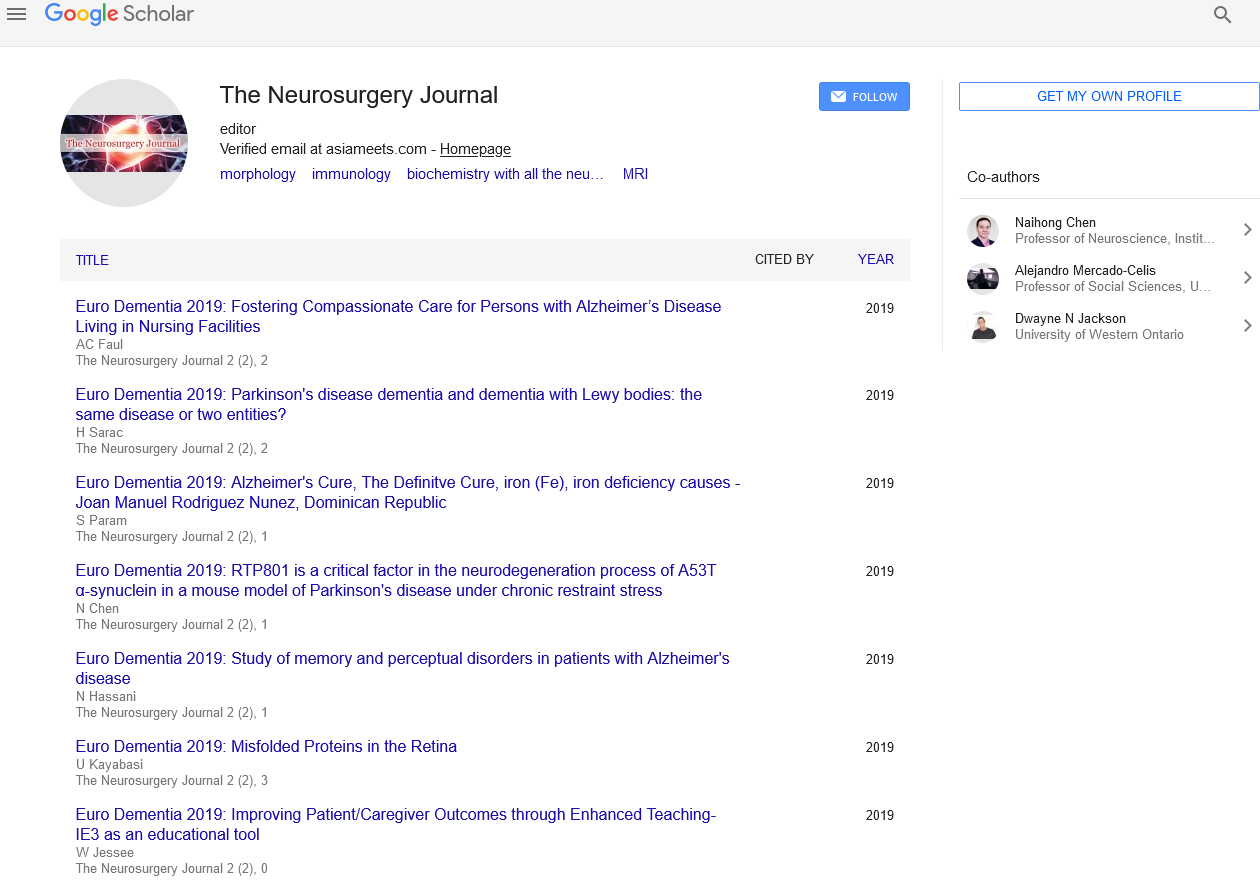a brief note on degenerative disc disease
Received: 04-Oct-2021 Accepted Date: Oct 18, 2021; Published: 25-Oct-2021
Citation: Eco G. A brief note on degenerative disc disease. Neurosurg J. 2021;4(2):2.
This open-access article is distributed under the terms of the Creative Commons Attribution Non-Commercial License (CC BY-NC) (http://creativecommons.org/licenses/by-nc/4.0/), which permits reuse, distribution and reproduction of the article, provided that the original work is properly cited and the reuse is restricted to noncommercial purposes. For commercial reuse, contact reprints@pulsus.com
Description
Degenerative Disc Disease (DDD) is an ailment in which, it causes anatomic changes and a lack of potentiality in varying levels of at least one intervertebral disc of the spine of adequate dimensions to cause symptoms. There might be sickness, insensibility, and discomfort that emanate down the leg.
The spinal disks are in conjunction with a soft inner core and a tough outer wall. The disks alter in different ways that may result in degenerative disk disease like:
Dry out: At the time of birth, the disks in the spine are constituted with water. As the individual age, they lose water and get slender. Flatter disks can't take in shocks too. The water-dropping further implies less cushion or padding between the vertebrae results in various conditions in the spine that may cause discomfort.
Crack: The pressure of daily activities and slighter wounds throughout the years may result in micro-tears in the outer wall, which contains nerves. Any tears close to the nerves may lead to distress. Moreover, if the wall breaks down, the disk's softcore may push through the cracks. The disk may swell or slip out of place, which is called a slipped or herniated disk. It may influence close nerves.
The treatment which is incorporated in the management of DDD is occupational therapy, physical therapy, or both special exercises, medications, losing weight, and surgery.
Clinical choices include infusing the joints close to the harmed plate with steroids and a neighborhood sedative. These are called aspect joint infusions. They can give viable help with discomfort.
Facet rhizotomy is a radiofrequency current that weakens the nerves around the facet joint, averting pain signals which are ending at the brain. Patients who react effectively to facet joint infusions may gain from these. Analgesic may take over a year.
Intradiscal electrothermal annuloplasty (IDET) includes embedding a catheter into the disc and heating it. It seems to relieve pain, probably by resulting collagen to contract which sorts out damage in the disc. The specific mechanism lasts indefinitely.
Medicaments include analgesic medicament, like Tylenol, and non-steroidal anti-inflammatory drugs (NSAIDs), such as ibuprofen. Steroids and muscle relaxants may additionally be advised.
The specialist may inquire about the symptoms like when did it occur, at what regions the aggravation took place, with no regard that there is tingling or insensibility, and which circumstances cause the most discomfort. Additionally, inquires about any falls, injuries, or accidents.
The physical evaluation includes:
• Muscle strength includes examining for atrophy, wasting, or abnormal movements.
• Discomfort with movement or in reaction to touch involves the patient moving in specific ways. If stress applied to the lower back cause discomfort, then there may be a degenerated disc.
• Nerve function involves where the doctor taps various regions with a reflex hammer. If it results in no response shows a compressed nerve root.
• Diagnostic tests include:
• Imaging scans, such as CT or MRI, accumulate data about the condition of the spinal nerves, the discs, and how they are aligned.
• A discogram includes infusing a dye into the soft center of the disc or a few discs. The point is to see if the disc is distress. This dye appears in the output. Discogram utilization may be contentious, anyhow, as herniated discs do not always cause symptoms.
• The specialist may likewise test for different conditions, like cancer or various sorts of impairment, to guarantee an accurate diagnosis.
• Patients who don't react to moderate treatments inside around 90 days might think about a medical procedure which might be a choice in case there is:
• Back or leg pain that prevents the patient from doing daily exercises.
• Trouble in standing or walking
• The surgical alternatives available are Stabilization surgery or spinal fusion, stabilization surgery or spinal fusion, stem cell therapy.





